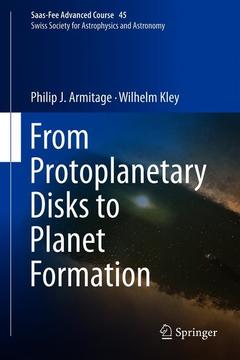Description
From Protoplanetary Disks to Planet Formation, 1st ed. 2019
Saas-Fee Advanced Course 45. Swiss Society for Astrophysics and Astronomy
Saas-Fee Advanced Course Series, Vol. 45
Authors: Armitage Philip J., Kley Wilhelm
Coordinators: Audard Marc, Meyer Michael R., Alibert Yann
Language: English
Subjects for From Protoplanetary Disks to Planet Formation:
Approximative price 116.04 €
In Print (Delivery period: 15 days).
Add to cart260 p. · 15.5x23.5 cm · Hardback
Description
/li>Contents
/li>Biography
/li>Comment
/li>
Is the Sun and its planetary system special? How did the Solar system form? Are there similar systems in the Galaxy? How common are habitable planets? What processes take place in the early life of stars and in their surrounding circumstellar disks that could impact whether life emerges or not?
This book is based on the lectures by Philip Armitage and Wilhelm Kley presented at 45th Saas-Fee Advanced Course ?From Protoplanetary Disks to Planet Formation? of the Swiss Society for Astrophysics and Astronomy. The first part deals with the physical processes occurring in proto-planetary disks starting with the observational context, structure and evolution of the proto-planetary disk, turbulence and accretion, particle evolution and structure formation. The second part covers planet formation and disk-planet interactions. This includes in detail dust and planetesimal formation, growth to protoplanets, terrestrial planet formation, giant planet formation, migration of planets, multi-planet systems and circumbinary planets.
As Saas-Fee advanced course this book offers PhD students an in-depth treatment of the topic enabling them to enter on a research project in the field.The authors:
Philip Armitage was born in 1971 just outside of London in Sevenoaks, Kent, England. At Cambridge University, he studied physics and theoretical physics, earning a B. A. in 1993. He earned a doctorate in 1996 for a study of accretion disks around young stars with Cathie Clark at Cambridge’s Institute of Astronomy. He was then a postdoc at the Canadian Institute of Theoretical Astrophysics at the University of Toronto (1996–1999). At Toronto, he continued his studies of accretion disks and began studies of planet formation. Next, he spent another postdoctoral year at the Max Planck Institute for Astrophysics in Munich. From 2000 to 2002 he was assistant professor at the University of St. Andrews in Scotland, and has been an assistant, associate and then full professor of the Department of Astrophysical and Planetary Sciences at the University of Colorado and Fellow of JILA since 2002. He has continued his research on accretion disks, on the formation and evolution of extrasolar planetary systems, and on the astrophysics of black holes. In 2018 he took up a joint position at Stony Brook University and the Center for Computational Astrophysics at the Flatiron Institute.
Wilhelm Kley studied physics and astronomy at the Universities of Bochum, Sussex and Munich. He obtained his PhD in physics at the Ludwig-Maximilians University (München) in 1988, and spent then 3 years as postdoc time at UC Santa Cruz and Queen Mary College London. He stayed for 6 years at Friedrich Schiller University (Jena) as postdoc and senior researcher, and another year as postdoc at Max-Planck Institute for Astronomy (Heidelberg). Since October 2001 he is full professor of Computational Physics at Eberhard-Karls University Tübingen. The focus of his research lies in the fields of Computational Astrophysics, Planet Formation, Accretion Disk Physics.
The editors:
Marc Audard (born 1974, M. Sc Physics, University of Lausanne; PhD, ETHZ) works on star for
Offers an in-depth introduction to the field of planet formation
Based on lectures given by world-class specialists
In the highly acclaimed series of Saas-Fee Advanced Courses by the Swiss Society for Astrophysics and Astronomy




